Android Internal Storage Example
We are able to save or read data from the device internal memory. FileInputStream and FileOutputStream classes are used to read and write data into the file.
Here, we are going to read and write data to the internal storage of the device.
Example of reading and writing data to the android internal storage
activity_main.xml
Drag the 2 edittexts, 2 textviews and 2 buttons from the pallete, now the activity_main.xml file will like this:
File: activity_main.xml
- <RelativeLayout xmlns:android="http://schemas.android.com/apk/res/android"
- xmlns:tools="http://schemas.android.com/tools"
- android:layout_width="match_parent"
- android:layout_height="match_parent"
- tools:context=".MainActivity" >
- <EditText
- android:id="@+id/editText1"
- android:layout_width="wrap_content"
- android:layout_height="wrap_content"
- android:layout_alignParentRight="true"
- android:layout_alignParentTop="true"
- android:layout_marginRight="20dp"
- android:layout_marginTop="24dp"
- android:ems="10" >
- <requestFocus />
- </EditText>
- <EditText
- android:id="@+id/editText2"
- android:layout_width="wrap_content"
- android:layout_height="wrap_content"
- android:layout_alignRight="@+id/editText1"
- android:layout_below="@+id/editText1"
- android:layout_marginTop="24dp"
- android:ems="10" />
- <TextView
- android:id="@+id/textView1"
- android:layout_width="wrap_content"
- android:layout_height="wrap_content"
- android:layout_alignBaseline="@+id/editText1"
- android:layout_alignBottom="@+id/editText1"
- android:layout_alignParentLeft="true"
- android:text="File Name:" />
- <TextView
- android:id="@+id/textView2"
- android:layout_width="wrap_content"
- android:layout_height="wrap_content"
- android:layout_alignBaseline="@+id/editText2"
- android:layout_alignBottom="@+id/editText2"
- android:layout_alignParentLeft="true"
- android:text="Data:" />
- <Button
- android:id="@+id/button1"
- android:layout_width="wrap_content"
- android:layout_height="wrap_content"
- android:layout_alignLeft="@+id/editText2"
- android:layout_below="@+id/editText2"
- android:layout_marginLeft="70dp"
- android:layout_marginTop="16dp"
- android:text="save" />
- <Button
- android:id="@+id/button2"
- android:layout_width="wrap_content"
- android:layout_height="wrap_content"
- android:layout_alignBaseline="@+id/button1"
- android:layout_alignBottom="@+id/button1"
- android:layout_toRightOf="@+id/button1"
- android:text="read" />
- </RelativeLayout>
Activity class
Let's write the code to write and read data from the internal storage.
File: MainActivity.java
- package example.javatpoint.com.internalstorage;
- import android.content.Context;
- import android.support.v7.app.AppCompatActivity;
- import android.os.Bundle;
- import android.view.View;
- import android.widget.Button;
- import android.widget.EditText;
- import android.widget.Toast;
- import java.io.BufferedReader;
- import java.io.FileNotFoundException;
- import java.io.FileOutputStream;
- import java.io.IOException;
- import java.io.InputStreamReader;
- public class MainActivity extends AppCompatActivity {
- EditText editTextFileName,editTextData;
- Button saveButton,readButton;
- @Override
- protected void onCreate(Bundle savedInstanceState) {
- super.onCreate(savedInstanceState);
- setContentView(R.layout.activity_main);
- editTextFileName=findViewById(R.id.editText1);
- editTextData=findViewById(R.id.editText2);
- saveButton=findViewById(R.id.button1);
- readButton=findViewById(R.id.button2);
- //Performing Action on Read Button
- saveButton.setOnClickListener(new View.OnClickListener(){
- @Override
- public void onClick(View arg0) {
- String filename=editTextFileName.getText().toString();
- String data=editTextData.getText().toString();
- FileOutputStream fos;
- try {
- fos = openFileOutput(filename, Context.MODE_PRIVATE);
- //default mode is PRIVATE, can be APPEND etc.
- fos.write(data.getBytes());
- fos.close();
- Toast.makeText(getApplicationContext(),filename + " saved",
- Toast.LENGTH_LONG).show();
- } catch (FileNotFoundException e) {e.printStackTrace();}
- catch (IOException e) {e.printStackTrace();}
- }
- });
- //Performing Action on Read Button
- readButton.setOnClickListener(new View.OnClickListener(){
- @Override
- public void onClick(View arg0) {
- String filename=editTextFileName.getText().toString();
- StringBuffer stringBuffer = new StringBuffer();
- try {
- //Attaching BufferedReader to the FileInputStream by the help of InputStreamReader
- BufferedReader inputReader = new BufferedReader(new InputStreamReader(
- openFileInput(filename)));
- String inputString;
- //Reading data line by line and storing it into the stringbuffer
- while ((inputString = inputReader.readLine()) != null) {
- stringBuffer.append(inputString + "\n");
- }
- } catch (IOException e) {
- e.printStackTrace();
- }
- //Displaying data on the toast
- Toast.makeText(getApplicationContext(),stringBuffer.toString(),Toast.LENGTH_LONG).show();
- }
- });
- }
- }
Output:
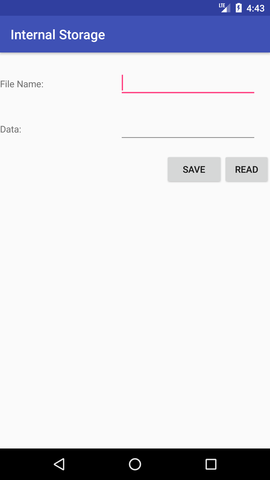
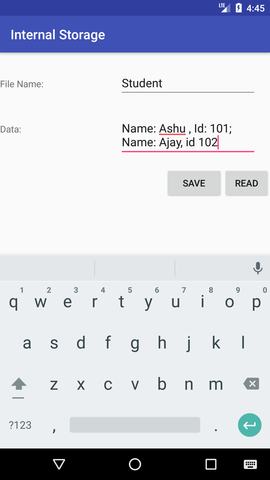
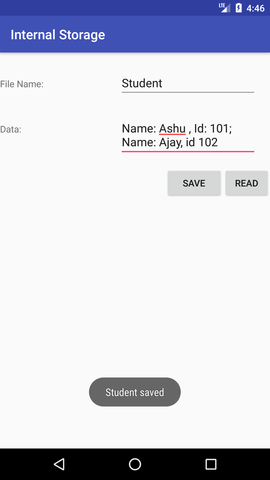
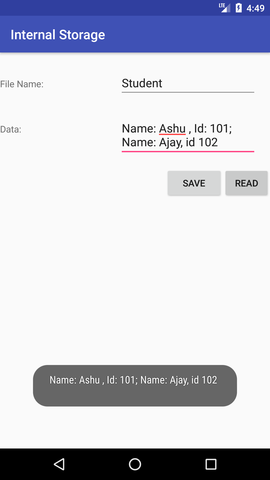
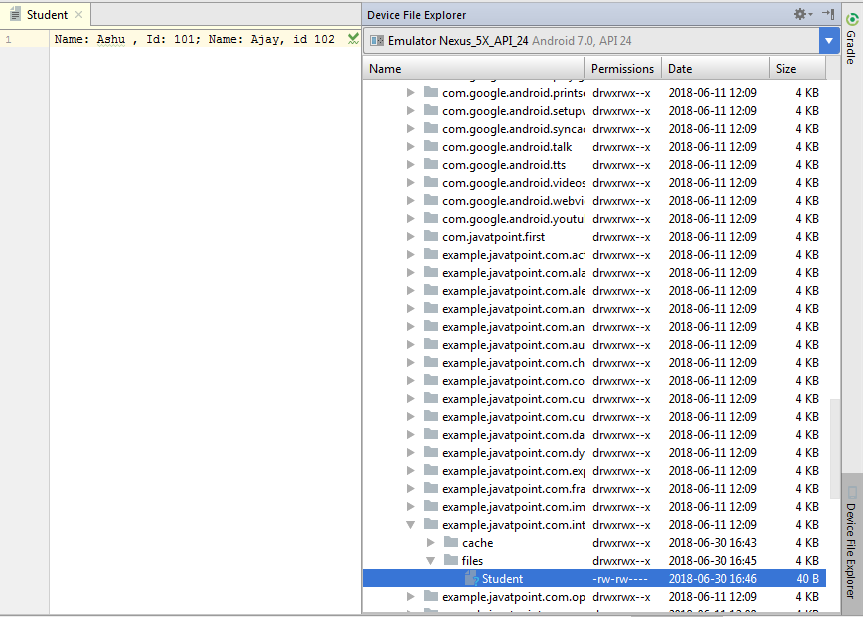
No comments:
Post a Comment